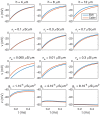An Evaluation of the Accuracy of Classical Models for Computing the Membrane Potential and Extracellular Potential for Neurons
- PMID: 28484385
- PMCID: PMC5401906
- DOI: 10.3389/fncom.2017.00027
An Evaluation of the Accuracy of Classical Models for Computing the Membrane Potential and Extracellular Potential for Neurons
Abstract
Two mathematical models are part of the foundation of Computational neurophysiology; (a) the Cable equation is used to compute the membrane potential of neurons, and, (b) volume-conductor theory describes the extracellular potential around neurons. In the standard procedure for computing extracellular potentials, the transmembrane currents are computed by means of (a) and the extracellular potentials are computed using an explicit sum over analytical point-current source solutions as prescribed by volume conductor theory. Both models are extremely useful as they allow huge simplifications of the computational efforts involved in computing extracellular potentials. However, there are more accurate, though computationally very expensive, models available where the potentials inside and outside the neurons are computed simultaneously in a self-consistent scheme. In the present work we explore the accuracy of the classical models (a) and (b) by comparing them to these more accurate schemes. The main assumption of (a) is that the ephaptic current can be ignored in the derivation of the Cable equation. We find, however, for our examples with stylized neurons, that the ephaptic current is comparable in magnitude to other currents involved in the computations, suggesting that it may be significant-at least in parts of the simulation. The magnitude of the error introduced in the membrane potential is several millivolts, and this error also translates into errors in the predicted extracellular potentials. While the error becomes negligible if we assume the extracellular conductivity to be very large, this assumption is, unfortunately, not easy to justify a priori for all situations of interest.
Keywords: cable equation; ephaptic coupling; extracellular potential; membrane potentials; numerical modeling.
Figures











Similar articles
-
Multimodal Modeling of Neural Network Activity: Computing LFP, ECoG, EEG, and MEG Signals With LFPy 2.0.Front Neuroinform. 2018 Dec 18;12:92. doi: 10.3389/fninf.2018.00092. eCollection 2018. Front Neuroinform. 2018. PMID: 30618697 Free PMC article.
-
Electrical interactions via the extracellular potential near cell bodies.J Comput Neurosci. 1999 Mar-Apr;6(2):169-84. doi: 10.1023/a:1008832702585. J Comput Neurosci. 1999. PMID: 10333161
-
Neuronal coupling by endogenous electric fields: cable theory and applications to coincidence detector neurons in the auditory brain stem.J Neurophysiol. 2016 Apr;115(4):2033-51. doi: 10.1152/jn.00780.2015. Epub 2016 Jan 28. J Neurophysiol. 2016. PMID: 26823512 Free PMC article.
-
A finite element method framework to model extracellular neural stimulation.J Neural Eng. 2022 Apr 7;19(2). doi: 10.1088/1741-2552/ac6060. J Neural Eng. 2022. PMID: 35320783 Review.
-
Development of volume conductor and source models to localize epileptic foci.J Clin Neurophysiol. 2007 Apr;24(2):101-19. doi: 10.1097/WNP.0b013e318038fb3e. J Clin Neurophysiol. 2007. PMID: 17414966 Review.
Cited by
-
Evaluating computational efforts and physiological resolution of mathematical models of cardiac tissue.Sci Rep. 2024 Jul 23;14(1):16954. doi: 10.1038/s41598-024-67431-w. Sci Rep. 2024. PMID: 39043725 Free PMC article.
-
PyPNS: Multiscale Simulation of a Peripheral Nerve in Python.Neuroinformatics. 2019 Jan;17(1):63-81. doi: 10.1007/s12021-018-9383-z. Neuroinformatics. 2019. PMID: 29948844 Free PMC article.
-
Deriving the Bidomain Model of Cardiac Electrophysiology From a Cell-Based Model; Properties and Comparisons.Front Physiol. 2022 Jan 7;12:811029. doi: 10.3389/fphys.2021.811029. eCollection 2021. Front Physiol. 2022. PMID: 35069265 Free PMC article.
-
Electrophysiological damage to neuronal membrane alters ephaptic entrainment.Sci Rep. 2023 Jul 24;13(1):11974. doi: 10.1038/s41598-023-38738-x. Sci Rep. 2023. PMID: 37488148 Free PMC article.
-
A Kirchhoff-Nernst-Planck framework for modeling large scale extracellular electrodiffusion surrounding morphologically detailed neurons.PLoS Comput Biol. 2018 Oct 4;14(10):e1006510. doi: 10.1371/journal.pcbi.1006510. eCollection 2018 Oct. PLoS Comput Biol. 2018. PMID: 30286073 Free PMC article.
References
-
- Agudelo-Toro A. (2012). Numerical Simulations on the Biophysical Foundations of the Neuronal Extracellular Space. Ph.D. thesis, Niedersächsische Staats-und Universitätsbibliothek Göttingen.
-
- Arvanitaki A. (1942). Effects evoked in an axon by the activity of a contiguous one. J. Neurophysiol. 5, 89–108.
LinkOut - more resources
Full Text Sources
Other Literature Sources

